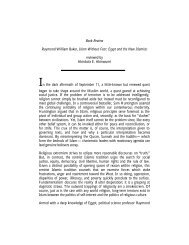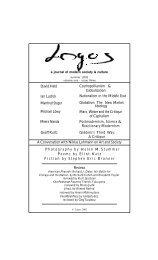Michael J. Thompson Stephen Eric Bronner Wadood Hamad - Logos
Michael J. Thompson Stephen Eric Bronner Wadood Hamad - Logos
Michael J. Thompson Stephen Eric Bronner Wadood Hamad - Logos
You also want an ePaper? Increase the reach of your titles
YUMPU automatically turns print PDFs into web optimized ePapers that Google loves.
Stanley Aronowitz<br />
the underlying population, the system might be endangered. The military, as a<br />
relatively autonomous power center, gained sustenance from the rearmament<br />
program leading to World War II but since there was no peace after 1945, it<br />
retained its central position in the power structure. Almost immediately the<br />
United States and the Soviet Union, the two remaining superpowers, were<br />
engaged in a new “cold” war in which nuclear and conventional weapons<br />
played an enormous economic as well as political role in world and domestic<br />
politics. And the cold aspects of the war were punctuated by discontinuous,<br />
but frequent, “hot” wars such as those in Korea, Southeast Asia, China, and<br />
Israel. Under these circumstances, the military, allying itself with those large<br />
corporations engaged in defense production, accumulated substantial<br />
independent power. Needless to say, the corporations, the holders of what he<br />
calls “big money,” are by no means ignored. After all, they remain the<br />
backbone of the entire system.<br />
But in his analysis of the commanding heights, Mills is not content to describe<br />
the three institutional orders that comprise the power élite. He shows that the<br />
scope of its power embraces wide sections upon which the legitimacy of<br />
American society depends. Chief among them are the celebrities who, as the<br />
premier ornaments of mass society, are routinely recruited to lend prestige to<br />
the high officials of the three principal institutions of power. Political parties<br />
and their candidates eagerly showcase celebrities who support them; corporate<br />
executives regularly mingle with celebrities in Hollywood and New York at<br />
exclusive clubs and parties; and “warlords”—high military officers, corporate<br />
officials, their scientists and technologists engaged in perfecting more lethal<br />
weapons of mass destruction, the politicians responsible for executive and<br />
congressional approval of military budgets—congregate in many of the same<br />
social and cultural spaces as well as in the business suites of warfare. In short,<br />
following the muckraking tradition, but also international sociological<br />
discourse on power, The Power Elite uses the evidentiary method first<br />
perfected by the independent scholars such as Ferdinand Lundberg of tracing<br />
interlocking networks of social and cultural association as much as business<br />
relationship to establish the boundaries and contour of power. Moreover, in<br />
this work we can see the movement of individuals among the leading<br />
institutional orders that constitute the nexus of power, so that their difference<br />
tends to blur.<br />
<strong>Logos</strong> 2.3 – Summer 2003




